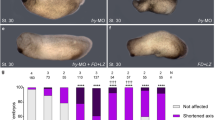Abstract
Wnt glycoproteins have been implicated in diverse processes during embryonic patterning in metazoa. They signal through frizzled-type seven-transmembrane-domain receptors to stabilize β-catenin1,2. Wnt signalling is antagonized by the extracellular Wnt inhibitor dickkopf1 (dkk1), which is a member of a multigene family3. dkk1 was initially identified as a head inducer in Xenopus embryos but the mechanism by which it blocks Wnt signalling is unknown. LDL-receptor-related protein 6 (LRP6) is required during Wnt/β-catenin signalling in Drosophila, Xenopus and mouse, possibly acting as a co-receptor for Wnt4,5,6. Here we show that LRP6 (ref. 7) is a specific, high-affinity receptor for Dkk1 and Dkk2. Dkk1 blocks LRP6-mediated Wnt/β-catenin signalling by interacting with domains that are distinct from those required for Wnt/Frizzled interaction. dkk1 and LRP6 interact antagonistically during embryonic head induction in Xenopus where LRP6 promotes the posteriorizing role of Wnt/β-catenin signalling. Thus, DKKs inhibit Wnt co-receptor function, exemplifying the modulation of LRP signalling by antagonists.
This is a preview of subscription content, access via your institution
Access options
Subscribe to this journal
Receive 51 print issues and online access
$199.00 per year
only $3.90 per issue
Buy this article
- Purchase on Springer Link
- Instant access to full article PDF
Prices may be subject to local taxes which are calculated during checkout





Similar content being viewed by others
References
Wodarz, A. & Nusse, R. Mechanisms of Wnt signaling in development. Annu. Rev. Cell. Dev. Biol. 14, 59–88 (1998).
Miller, J. R., Hocking, A. M., Brown, J. D. & Moon, R. T. Mechanism and function of signal transduction by the Wnt/beta-catenin and Wnt/Ca2+ pathways. Oncogene 18, 7860–7872 (1999).
Glinka, A. et al. Dickkopf-1 is a member of a new family of secreted proteins and functions in head induction. Nature 391, 357–362 (1998).
Pinson, K. I., Brennan, J., Monkley, S., Avery, B. J. & Skarnes, W. C. An LDL-receptor-related protein mediates Wnt signalling in mice. Nature 407, 535–538 (2000).
Tamai, K. et al. LDL-receptor-related proteins in Wnt signal transduction. Nature 407, 530–535 (2000).
Wehrli, M. et al. arrow encodes an LDL-receptor-related protein essential for Wingless signalling. Nature 407, 527–530 (2000).
Brown, S. D. et al. Isolation and characterization of LRP6, a novel member of the low density lipoprotein receptor gene family. Biochem. Biophys. Res. Commun. 248, 879–888 (1998).
Rattner, A. et al. A family of secreted proteins contains homology to the cysteine-rich ligand binding domain of frizzled receptors. Proc. Natl Acad. Sci. USA 94, 2859–2863 (1997).
Monaghan, A. P. et al. Dickkopf genes are co-ordinately expressed in mesodermal lineages. Mech. Dev. 87, 45–56 (1999).
Smith, W. C. & Harland, R. M. Expression cloning of noggin, a new dorsalizing factor localized to the Spemann organizer in Xenopus embryos. Cell 70, 829–840 (1992).
Bouwmeester, T., Kim, S.-H., Sasai, Y., Lu, B. & De Robertis, E. M. Cerberus is a head-inducing secreted factor expressed in the anterior endoderm of Spemann's organizer. Nature 382, 595–601 (1996).
Korinek, V. et al. Constitutive transcriptional activation by a beta-catenin-Tcf complexes in APC/ colon carcinoma. Science 275, 1784–1787 (1997).
Brannon, M. & Kimelman, D. Activation of Siamois by the Wnt pathway. Dev. Biol. 180, 344–347 (1996).
Carnac, G., Kodjachbachian, L., Gurdon, J. B. & Lemaire, P. The homeobox gene siamois is a target of the wnt dorsalization pathway and triggers organiser activity in the absence of mesoderm. Development 122, 3055–3065 (1996).
Wu, W., Glinka, A., Delius, H. & Niehrs, C. Mutual antagonism between dickkopf1 and-2 regulates Wnt/beta-catenin signalling. Curr. Biol. 10, 1611–1614 (2000).
Niehrs, C. Head in the Wnt—the molecular nature of Spemann's head organizer. Trends Genet. 15, 314–319 (1999).
Christian, J. L. & Moon, R. T. Interactions between Xwnt-8 and Spemann organizer signaling pathways generate dorsoventral pattern in the embryonic mesoderm of Xenopus. Genes Dev. 7, 13–28 (1993).
Leyns, L., Bouwmeester, T., Kim, S.-H., Piccolo, S. & De Robertis, E. M. Frzb-1 is a secreted antagonist of wnt-signals expressed in the Spemann organizer. Cell 88, 747–756 (1997).
Piccolo, S. et al. The head inducer Cerberus is a multifunctional antagonist of Nodal, BMP and Wnt signals. Nature 397, 707–710 (1999).
Hsieh, J. C. et al. A new secreted protein that binds to Wnt proteins and inhibits their activities. Nature 398, 431–436 (1999).
Willnow, T. E., Nykjaer, A. & Herz, J. Lipoprotein receptors: new roles for ancient proteins. Nature Cell Biol. 1, E157–162 (1999).
Gawantka, V., Delius, H., Hirschfeld, K., Blumenstock, C. & Niehrs, C. Antagonizing the Spemann organizer: role of the homeobox gene Xvent-1. EMBO J. 14, 6268–6279 (1995).
Cheng, H. J., Nakamoto, M., Bergemann, A. D. & Flanagan, J. G. Complementary gradients in expression and binding of ELF-1 and Mek4 in development of the topographic retinotectal projection map. Cell 82, 371–381 (1995).
Cheng, H. J. & Flanagan, J. G. Identification and cloning of ELF-1, a developmentally expressed ligand for the Mek4 and Sek receptor tyrosine kinases. Cell 79, 157–168 (1994).
Hsieh, J. C., Rattner, A., Smallwood, P. M. & Nathans, J. Biochemical characterization of Wnt-frizzled interactions using a soluble, biologically active vertebrate Wnt protein. Proc. Natl Acad. Sci. USA 96, 3546–3551 (1999).
Glinka, A., Wu, W., Onichtchouk, D., Blumenstock, C. & Niehrs, C. Head induction by simultaneous repression of Bmp and wnt signalling in Xenopus. Nature 389, 517–519 (1997).
Acknowledgements
We thank X. He for reagents and advice; J. Nathans and P. Ramulu for the unpublished pRKdkk1–AP and other plasmids; and H. Clevers, S. Cohen, J. Flanagan, J. Herz, R. Moon, S. Sokol and N. Ueno for other materials. This work was supported in part by the Deutsche Forschungsgemeinschaft.
Author information
Authors and Affiliations
Corresponding author
Rights and permissions
About this article
Cite this article
Mao, B., Wu, W., Li, Y. et al. LDL-receptor-related protein 6 is a receptor for Dickkopf proteins. Nature 411, 321–325 (2001). https://doi.org/10.1038/35077108
Received:
Accepted:
Published:
Issue Date:
DOI: https://doi.org/10.1038/35077108
Comments
By submitting a comment you agree to abide by our Terms and Community Guidelines. If you find something abusive or that does not comply with our terms or guidelines please flag it as inappropriate.



